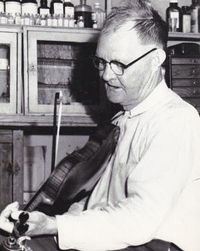Annotation:Pigeon on the Gate (4): Difference between revisions
No edit summary |
m (Text replacement - "garamond, serif" to "sans-serif") |
||
| (One intermediate revision by one other user not shown) | |||
| Line 1: | Line 1: | ||
=='''Back to [[{{BASEPAGENAME}}]]'''== | =='''Back to [[{{BASEPAGENAME}}]]'''== | ||
---- | ---- | ||
<p><font face=" | <p><font face="sans-serif" size="4"> | ||
'''PIGEON ON THE GATE [4].''' AKA - "Pigeon on the Gatepost (3)." Old-Time, Breakdown. USA, West Virginia. D Major. ADae tuning (fiddle). Identified by Doc White (1889-1974) of Ivydale, Clay County, West Virginia, as a West Virginia tune featured by blind northeastern Kentucky fiddler Ed Hayley. White said of Hayley, "He was the best fiddler I ever heard draw a bow." White himself was a jack-of-all trades and sometime dentist, physician and midwife, all self-schooled | '''PIGEON ON THE GATE [4].''' AKA - "Pigeon on the Gatepost (3)." Old-Time, Breakdown. USA, West Virginia. D Major. ADae tuning (fiddle). Identified by Doc White (1889-1974) of Ivydale, Clay County, West Virginia, as a West Virginia tune featured by blind northeastern Kentucky fiddler Ed Hayley. White said of Hayley, "He was the best fiddler I ever heard draw a bow." White himself was a jack-of-all trades and sometime dentist, physician and midwife, all self-schooled; he apprenticed with local practitioners and read every medical book he could get his hands on. Surprisingly, he was allowed to practice in rural Clay County. The tune is quite crooked, or irregular in metre. White can be heard playing it on AFS 13,704 (June, 1967). [[File:docwhite.jpg|200px|thumb|left|Doc White (''Jack Cawthon Photo'')]] | ||
<br> | <br> | ||
<br> | <br> | ||
</font></p> | </font></p> | ||
<p><font face=" | <p><font face="sans-serif" size="4"> | ||
''Source for notated version'': | ''Source for notated version'': | ||
<br> | <br> | ||
<br> | <br> | ||
</font></p> | </font></p> | ||
<p><font face=" | <p><font face="sans-serif" size="4"> | ||
''Printed sources'': | ''Printed sources'': | ||
<br> | <br> | ||
<br> | <br> | ||
</font></p> | </font></p> | ||
<p><font face=" | <p><font face="sans-serif" size="4"> | ||
''Recorded sources'': <font color=teal></font> | ''Recorded sources'': <font color=teal></font> | ||
<br> | <br> | ||
<br> | <br> | ||
</font></p> | </font></p> | ||
<p><font face=" | <p><font face="sans-serif" size="4"> | ||
See also listing at:<br> | See also listing at:<br> | ||
Hear Doc White's field recording at Slippery Hill [https://www.slippery-hill.com/recording/pigeon-gate][https://www.slippery-hill.com/system/files/recordings/PidgonOnGate.mp3]<br> | Hear Doc White's field recording at Slippery Hill [https://www.slippery-hill.com/recording/pigeon-gate][https://www.slippery-hill.com/system/files/recordings/PidgonOnGate.mp3]<br> | ||
Latest revision as of 14:34, 6 May 2019
Back to Pigeon on the Gate (4)
PIGEON ON THE GATE [4]. AKA - "Pigeon on the Gatepost (3)." Old-Time, Breakdown. USA, West Virginia. D Major. ADae tuning (fiddle). Identified by Doc White (1889-1974) of Ivydale, Clay County, West Virginia, as a West Virginia tune featured by blind northeastern Kentucky fiddler Ed Hayley. White said of Hayley, "He was the best fiddler I ever heard draw a bow." White himself was a jack-of-all trades and sometime dentist, physician and midwife, all self-schooled; he apprenticed with local practitioners and read every medical book he could get his hands on. Surprisingly, he was allowed to practice in rural Clay County. The tune is quite crooked, or irregular in metre. White can be heard playing it on AFS 13,704 (June, 1967).

Source for notated version:
Printed sources:
Recorded sources:
See also listing at:
Hear Doc White's field recording at Slippery Hill [1][2]
